Advertisement
Advertisement
They’re everywhere, they fight hard for their size, and they taste bloody great. But figuring out how to catch bream consistently takes more than blind luck and a snagged prawn. Whether you’re flicking soft plastics around oyster racks or soaking bait in a tidal gutter, bream can be finicky feeders. They are smart enough to turn their nose up at a poor presentation, but aggressive when you get it right.
In this guide, we’ll cover the different species of bream you’ll find around Australia, where to target them, and what gear to use. We will also discuss the best bait and lure strategies to help you catch a few for the pan.

There are three main bream species that are of significant importance to recreational anglers in Australia.
One of the most popular and widely distributed is the eastern yellowfin bream, also known as silver bream (Acanthopagrus australis). There is also a western yellowfin bream (A. latus). The eastern yellowfin bream has been reported to an impressive 66cm and 4.5kg.
The southern black bream, also known simply as black bream (Acanthopagrus butcheri), is another of our most common and widely occurring bream species. It is distinguishable from the yellowfin bream by more opaque (less translucent) and often darker anal and ventral fins. The black bream has been recorded to attain sizes of 60cm and 4kg. However, juveniles weighing up to 1.5kg are more commonly caught.
The third main species is the pikey bream, also known as black bream or northern bream or pikeys (Acanthopagrus berda). It can be differentiated from the other bream species by its lack of yellow fin colouration, charcoal tinge and generally deeper and more stout body shape. There is also a north-west black bream (A. palmaris). Pikeys have been reported to about 3kg, but they are far more commonly encountered at 300g-1kg.
To catch Yellowfin bream, you’ll need to head to both the coastal and estuarine waters of Eastern Australia. The regions range between Townsville in northern Queensland and Lakes Entrance in Victoria. The yellowfin enjoys a wide-ranging habitat from offshore reefs to the intertidal washes of islands, headlands and beaches. It also relishes our rivers and estuary systems and will venture into freshwater at times.
Black bream are almost exclusively found in estuarine systems from about Mallacoota in Victoria through South Australia and Tasmania to Shark Bay in Western Australia. This species is rarely found in offshore waters; preferring the estuaries and tidal (and sometimes land-locked) coastal lakes. They are regularly found in pure fresh water.
Pikey bream are our tropical bream. You can catch them across the top of Australia in estuarine and inshore coastal waters. This habitat ranges from Rockhampton in Queensland to Exmouth in Western Australia. Their habitat preference is for estuarine environs from the upper tidal and non-tidal limits of estuaries to the shallow coastal waters. This fish is very structure-oriented and often gathers and holds on to submerged fallen trees and rocky areas.

A few decades back, most Aussie bream were probably caught with handlines, and many still are. But these days, estuary breamers mainly prefer light to medium weight rods of around 1.8-2.3m. Anglers match these with threadline reels in the 1000-2500 sizes. Anglers specifically using lures tend toward braided main lines of 1-3kg, but they use nylon monofilaments of similar breaking strains for some lure applications.
Bait fishers often prefer nylon monofilament main lines. Nylon or fluorocarbon leaders are mainly used when braided main lines are employed. Beach- and rock-based anglers use longer rods than their estuary counterparts. Standard rock and beach fishing bream tackle would be medium-weight 2-4m rods, usually with threadline or Alvey-style centre-pin reels attached. These are loaded with 3-6kg nylon monofilament line.
Fresh and live baits such as pink nippers, prawns, cut fish flesh, shrimp, crabs, cunji, beach, blood and squirt worms, as well as various molluscs, are all superb for catching bream. They are best collected at your fishing location. Prepared baits such as pudding mixes, dough, bread, chicken gut and fillet steak will also account for the scavenging bream. Fine-gauge, sharp hooks should be sized to suit baits and use the least amount of lead (sinker) that conditions will allow.
While there are many good bream rigs available, the running ball sinker rig (allowed to run right through to the hook) is a great all-rounder. A good range (style, size and colour) of soft plastic, hard-bodied minnows, vibrating bladed and surface lures should all be carried by the hardcore bream luring enthusiasts. This is important because they can be quite finicky feeders and approaches often need to be varied and fine-tuned to the conditions and the many moods of the bream.

While bream will free-range, they are more likely to be found in or near structures. So, concentrate catching efforts around areas such as snags, oyster racks, rocky outcrops and bars, drop-offs, weed beds and sand banks on flooding tides. Small, soft, plastic lures presented on a light jig head, as conditions allow, can be a very effective way to target bream. Like all other lures, they should be either trolled or cast around the above-mentioned structure.
Small to medium-sized hard-bodied minnows work very well on bream. Retrieve speeds and styles should be varied until a successful recipe is found for that time and place. Semi-transparent, high-quality, Japanese-manufactured minnows are fooling the more educated bream.
Bream will quite readily accept a surface lure, most often during the warmer, high insect activity months. Small poppers, fizzers and saltwater flies can prove highly effective at these times.
If bait fishing for bream, you’ll increase your chances of a catch by presenting the bait in the most natural manner possible. Using tide, water movement and limited sinker weights to your advantage may help. Allowing a locally, naturally occurring bait to float around in a rocky headland wash or sudsy beach gutter are good examples.
Yes! All bream species offer good to excellent table qualities. They are a member of the same family as our gastronomically renowned southern snapper. For best table results, they should be dispatched (by brain spiking or spinal severing) immediately, bled and stored on ice.
Many bream anglers practice catch-and-release methods, which suit this hardy little fish.
Story by FishLife’s Scott Amon.
Interesting read on catching bream. In the late ‘60s I used to fish for bream on the Hawkesbury, not always with success. Use this bait, use that bait, wait for the right tide, moonlight etc. However, I worked on Cockatoo Island Dockyard and when on night shift I used to watch the Chinese crews from ships under repair fish off the Camel. All they had was a short line, they would sit under a light and simply jiggle the line, hey presto, all the fish they needed!